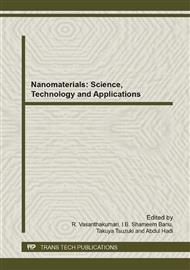p.85
p.91
p.97
p.103
p.108
p.114
p.118
p.123
p.128
Electrical Conductivity Properties of Nd2O3 Doped LiCl-PbO-ZnO Glass Ceramics
Abstract:
xNd2O3-35LiCl-(30-x)PbO-35ZnO glasses (where x=0.1, 0.2, 0.3, 0.4 and 0.5 mol %) were prepared by melt quenching method and converted to glass ceramics by controlled crystallization processes. Glass and glass ceramic phases were confirmed by XRD. The electrical conductivity of these samples has been carried out as a function of frequencies at different temperature. Ac conductivity data of these glasses has been analyzed using a single power law. The exponents obtained from the power law fits is found to be in the range from 0.2 0.3 in these glass ceramics and shows moderate temperature dependence. The stretched exponent β also is seen to vary slightly with temperature. Scaling behavior also has been carried out using the reduced plots of conductivity and frequency. The time-temperature superposition of data points is found to be satisfactory indicating that the ion transport mechanism decreases with annealing temperature and increase with compositions studied. Activation energy (Ea) has been calculated for all the samples at different temperatures, is found to vary in the range of 0.4eV to 0.5eV.
Info:
Periodical:
Pages:
108-113
Citation:
Online since:
June 2014
Authors:
Keywords:
Price:
Сopyright:
© 2014 Trans Tech Publications Ltd. All Rights Reserved
Share:
Citation:


